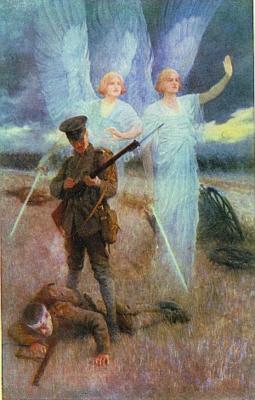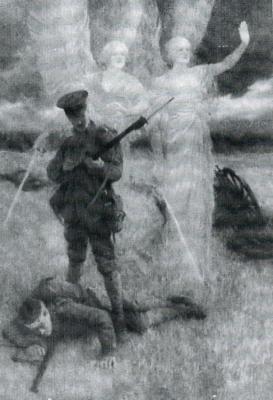By John Telfer, History Writer
It has been claimed by historians, that the military deaths in World War 1 were estimated to be around 8.5 million soldiers from both sides, and during this period many strange stories have emanated from the carnage and destruction.
Three of the most popular legends that received world-wide attention were; the Angel of Mons in 1914, The Leaning Virgin Mary of Albert and the little-known mystery of the missing Australian 10th Battalion soldiers, at Celtic Wood in 1917.
The first myth came during the British retreat from Mons in August, 1914. The legend that created the widely accepted theory that Divine intervention came about when a short story written by Arthur Machen appeared in London’s Evening Post on 29 September 1914.
Rumours from the battle front at Mons included a story that an angel had appeared in the sky over the battle field during the British retreat from Mons, after suffering heavy casualties. It caught the attention of a journalist from the London newspaper, “The Evening Post”, who wrote a story based on this supernatural event that phantom angels, armed with bows and arrows, were summoned by a soldier to destroy the enemy.
Although there was little evidence to support these claims, they gripped the war-weary English population so much that even religious and social reformers believed the story. There were even claims of dead German soldiers on the battle field with arrows in their body.
However, investigations of these so-called apparitions by the British Society of Physical Research discounted the claims, and the author later admitted that: “I had succeeded, unwittingly, in the art of deceit”. It did take a fair while before the story faded into mythology.
The second story that became a legend surrounding the small village of Albert in the French province of Picardy. Albert was situated right in the middle of the Allied advance to the Somme and sustained heavy damage from constant German shelling. Albert had, in the Village centre, an impressive Romanesque Basilica with a high tower that was crowned by a gilded statue of the Blessed Virgin Mary holding aloft the infant Jesus. As its tower commanded a wide view of the countryside, it became an observation post for both German and British forces. However, by 1916, and because of the damage from the shelling, the statue of Mary and the child Jesus was dislodged which caused it to lean precariously without toppling.
British and Anzac soldiers named it the “Leaning Virgin of Albert” and a folk legend was created in that when the statue fell, or was knocked down, the war would end. Soldiers advancing through the Menin Gate offered silent prayers to the leaning statue on their advance to the Battle of the Somme.
It was a legend that was firmly believed by the soldiers, however, in 1918 the whole tower was destroyed, but the legend lived on.
The other legend that was created concerned the mystery of the missing Company of soldiers from the 10th Battalion of the Australian 1st. Division, known as “The Terrible 10th” because of their fearless fighting reputation on Gallipoli.
The mystery surrounding the disappearance of the missing men centred on the Battle of Poelcappele, Belgium, on 9 October, 1917.
Field-Marshall Sir Douglas Haig, Commander-in-Chief, ordered the 10th Battalion Commander, Lieutenant -Colonel Maurice Wilder-Neligan, to attack Celtic Wood to make way for the advance to the Somme.
Celtic Wood was a small forest of trees that harboured the entrenched German 448th Regiment unit, and the German lines had dug in and contained many machine gun pill boxes that could meet any attack with deadly fire.
With heavy rain falling and mud up to their knees, the Company of 78 soldiers under the command of the young South Australian, Lieutenant Frank Scott, fixed their bayonets and went ‘over the top’ into the German emplacement in Celtic Wood.
They were last reported to be seen advancing through a heavy mist which they used for cover, but they were never seen again except for 14 survivors, thus leaving much speculation and rumour, as to what happened to the other men of the 10th on that fateful day.
The main rumour was that all the men were massacred by the Germans and buried in a mass grave, but no conclusive evidence has ever been found to support this.
Australian Defence Department of History, records a list 37 of the 85 missing and commented:
“On this day Lieutenant Scott of 10th Battalion led 84 men on a raid into enemy lines near Broodseinde. The main party was seen to enter Celtic Wood and were never seen again. Extensive investigations since that time have failed to fully account for the fate of Lt. Scott’s party. A total of 37 soldiers are still unaccounted for. This, is the greatest mystery for the AIF in WW1”.
Charles Bean, official war correspondent, wrote that the soldiers of Celtic Wood were never seen again as their names did not appear on any Red Cross POW lists; the War Graves Commission found no trace of bodies; German military records have no mention of an attack on Celtic Wood; and farmers in the nearby villages never knew about it, and the mystery of the 37 names could not be solved.
Even today, farmers of the area have told investigators that no bones or military equipment have ever been unearthed over the years that would shed light on the issue.
The eerie name of Celtic Wood conjured up rumours of supernatural happenings and helped create a mystery that really remains unsolved to this present day. In 2008, two researchers, Henschke and Kearney, felt that they had solved the mystery, when after some intensive investigation, they came to a conclusion in which they attributed the missing men to the “Fog of War”, (this expression means that there is “uncertainty in situational awareness experienced by participants in military operations”.)
They also said that misreporting and clerical errors could be another factor. However, this does not produce the main evidence required and that is: Where are the bodies of these brave men? Perhaps the heavy shelling that occurred could have obliterated the bodies of the missing men, but the best evidence needed would have to be in finding a burial site.
The Great War of 1914 – 1918 was a very tragic episode in the history of the 20th Century where millions on both sides alongside civilian casualties died, and the death rate will never, we hope, be surpassed.
However, legend, myth and mystery were a large part of the psyche on the average soldier, as records do show that many began to question their reasons for being part of this “war to end all wars”.
It is possible that the extremely high casualty rates made them feel that they would not survive and looked to lifting the morale that legend and myth could provide. It appears to be a 104-year-old mystery, that has never been officially solved.








